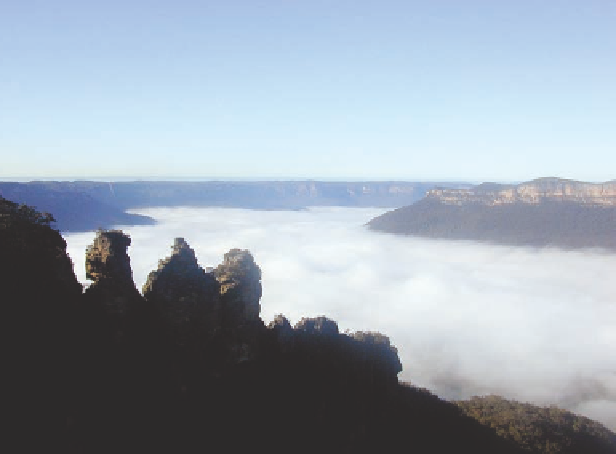Geoscience Reference
In-Depth Information
(b)
Figure 7.19 Types of fog.
(a) An excellent example of radiation fog in the Blue Mountains of Australia. This fog developed when nighttime
cold air collected in the valley bottom. It was entirely gone by late morning because the air in the valley had warmed above the dew-point
temperature. (b) Sea fog at San Francisco, California. This type of fog develops when moisture-laden air flows over cold water, causing the
air temperature to drop.
Precipitation
In contrast to ice crystallization, which is a process of va-
por attraction, raindrop coalescence is a process that merges
small water droplets into large ones (Figure 7.20b). This
process occurs mostly in tropical regions where the cloud
tops do not reach sufficiently high for liquid water to freeze.
Raindrop coalescence is the simple growth of water droplets
through the persistent collision of small droplets in the upper
atmosphere. One way in which this occurs is that large rain-
drops fall faster than smaller ones, allowing the larger rain-
drops to absorb the smaller droplets as they overtake them on
their fall to Earth.
Precipitation can occur in several forms:
As we just discussed, condensation of water vapor leads to the
formation of clouds. Cloud formation does not always lead to
precipitation, however, as clouds usually appear in the sky in
one form or another, and it certainly does not rain or snow ev-
ery time they do. This logically leads to the question,
why does
precipitation occur?
You probably already know that precipitation must involve
some kind of a phase change from vapor to liquid or from liquid
or vapor to solid. On the other hand, the nature of the process
might be a mystery to you, as it is to most people. The bottom
line is that precipitation does not occur until droplets of water
are heavy enough for them to fall under the influence of gravity.
Until then they remain suspended in the atmosphere.
• Rain—large,unfrozenwaterdroplets
• Snow—icecrystalsthatdonotmeltbeforereachingthe
surface
• Sleet—rainthatfreezesbeforehittingtheground
• Freezingrain—rainthatfreezesonimpactwithground
that is below the freezing point of water
• Hail—icecrystalsthatarecontinuallypulledbackupand
grow in size during violent thunderstorms
Types of Precipitation
Droplets grow in size and become heavier by two processes:
ice-crystal formation and coalescence of water droplets. Ice
crystallization is the dominant process in most places outside
the tropical regions and occurs because most clouds or portions
of clouds extend to altitudes where air temperatures are below
the freezing point of liquid water. In these places, ice crystals
occur in a matrix of water vapor and supercooled water drop-
lets that form around condensation nuclei (Figure 7.20a). The
ice crystals “feed” off of the water droplets in that they cause
droplets to rapidly evaporate when they are in close proximity
to one another. Subsequently, the ice crystals absorb the water
vapor that was released through the evaporation of the droplets,
causing them to grow. Assuming the crystals grow sufficiently
large in order to fall, they precipitate either as snowflakes or
melt on their way to the surface and become raindrops that can
grow further through the coalescence process.
This process is discussed in more detail in Chapter 8.
Precipitation Processes
As just described, precipitation occurs when water drops or ice
crystals become sufficiently large to fall under the force of grav-
ity. The only way that this can happen is for an air mass to rise
sufficiently high to condense large quantities of water. After all,
the simple formation of clouds does not necessarily mean that
precipitation will occur. How, then, does an air parcel rise to the
point where precipitation does occur?


